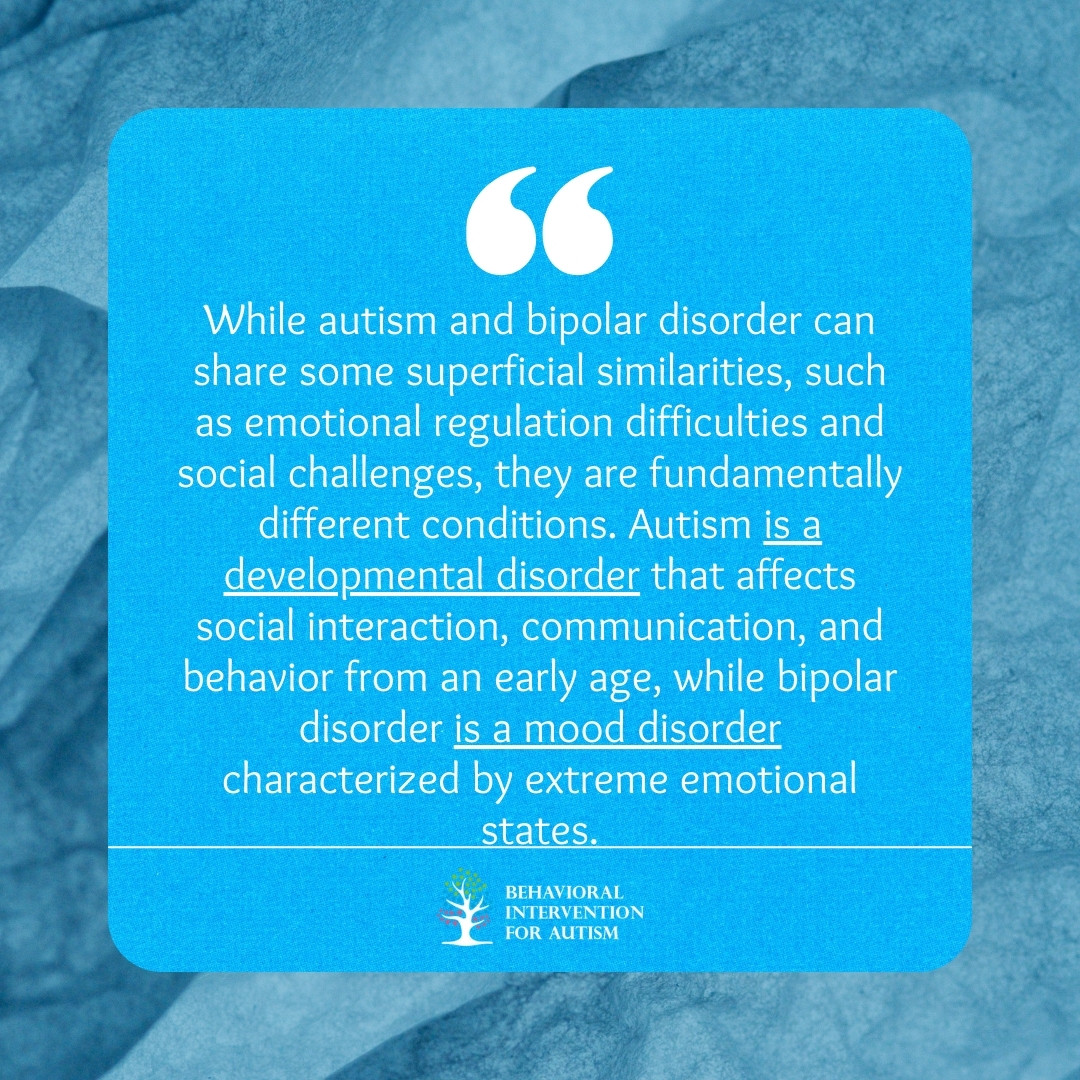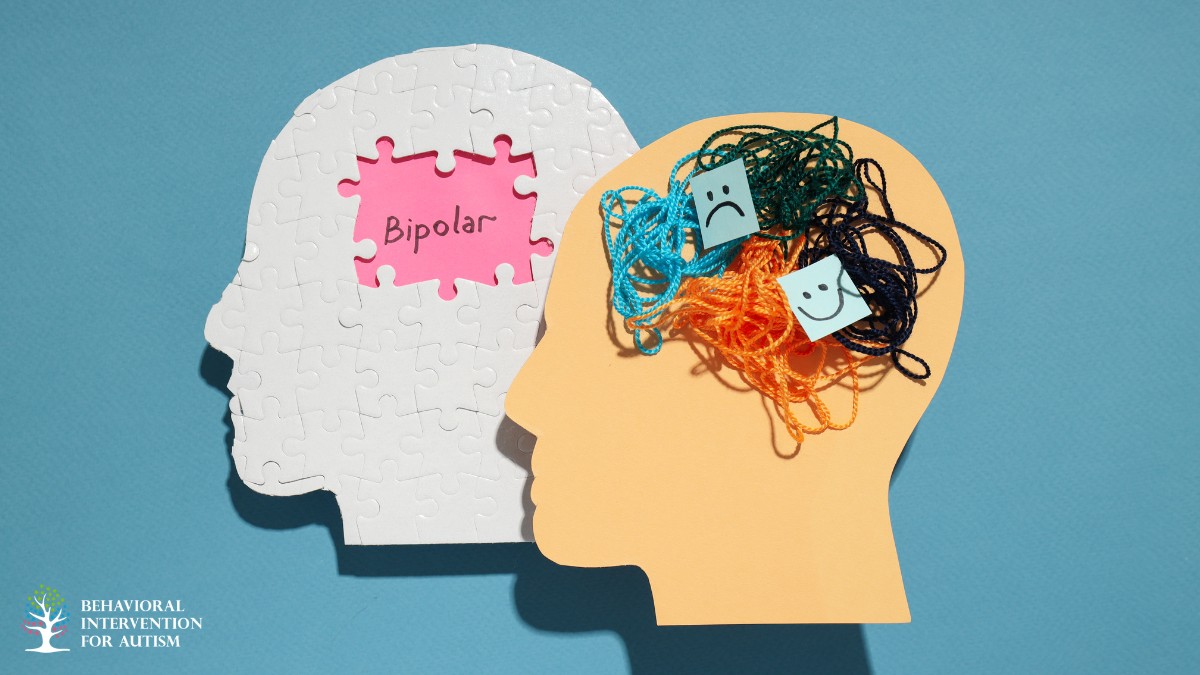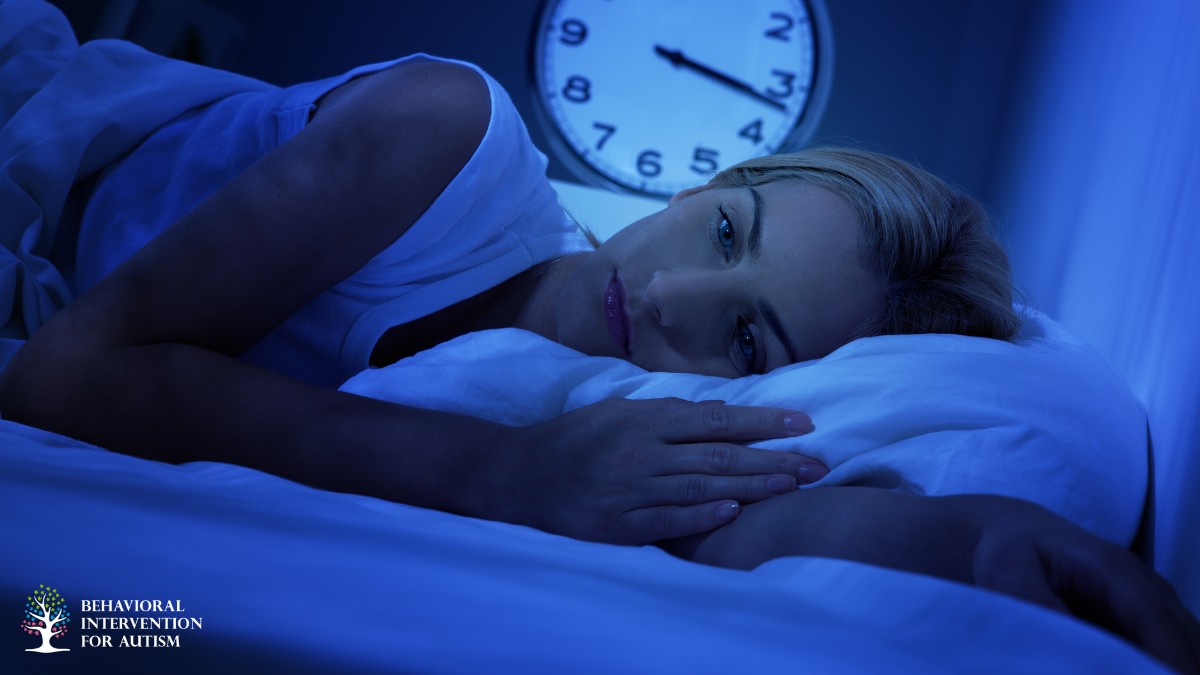
Table of Contents
Autism spectrum disorder (ASD) and bipolar disorder are two distinct neurological and psychological conditions that can significantly impact mental health. While they share some overlapping traits, their root causes, symptoms, and treatment approaches differ significantly. This article will explore the key similarities and differences between autism and bipolar disorder, aiming to provide a clearer understanding of each condition.
Are Autism and Bipolar Disorder Similar?
Yes, autism and bipolar disorder share some similarities, but they are distinct conditions. Both can affect behavior, mood, and social interaction, yet they have different underlying causes and symptoms. Autism is a developmental disorder, primarily characterized by challenges in social communication and restrictive behaviors, while bipolar disorder is a mood disorder marked by extreme shifts in mood, from manic episodes to depressive states.
Understanding Autism Spectrum Disorder (ASD)
Autism is a developmental disorder that affects a person’s ability to communicate, socialize, and process sensory information. It is a spectrum, meaning it manifests in various ways and to varying degrees in individuals. The exact cause of autism remains unclear, though genetics and environmental factors are believed to play significant roles.
Key Symptoms of Autism
Autism is typically characterized by difficulties in three core areas:
- Social Interaction: Individuals with autism may struggle with understanding social cues, forming relationships, and engaging in reciprocal conversations.
- Communication Challenges: People with autism may experience delayed language development, limited use of verbal and non-verbal communication, and difficulty with the nuances of language, such as sarcasm or tone.
- Restricted Interests and Repetitive Behaviors: Those on the autism spectrum often engage in repetitive actions, have intense interests in specific topics, and may exhibit a need for routines.
Autism is usually diagnosed in early childhood, with symptoms often becoming more apparent by the age of 2 to 3. Early intervention, particularly through therapies such as ABA (Applied Behavior Analysis), can greatly improve outcomes and help individuals with autism learn to navigate social and communication challenges.
What Is Bipolar Disorder?
Bipolar disorder, on the other hand, is a mood disorder that causes extreme mood swings, including manic episodes (elevated or irritable moods) and depressive episodes. These mood shifts can interfere with a person’s daily functioning and can be highly disruptive to relationships, work, and overall well-being.
Symptoms of Bipolar Disorder
Bipolar disorder is marked by alternating periods of manic highs and depressive lows. Symptoms may vary based on the type of bipolar disorder—type I, type II, or cyclothymia—but the core signs include:
- Manic Episodes: During these phases, individuals may experience elevated mood, increased energy, racing thoughts, impulsive behavior, and a decreased need for sleep.
- Depressive Episodes: Symptoms of depression include sadness, low energy, feelings of worthlessness, and a lack of interest in previously enjoyed activities.
- Mixed Episodes: Some people may experience symptoms of both mania and depression simultaneously, which can be particularly challenging to manage.
Bipolar disorder typically emerges in late adolescence or early adulthood, though it can be diagnosed in childhood or later in life. Proper treatment, which may include medication and therapy, can help manage the symptoms and prevent mood episodes.
Key Differences Between Autism and Bipolar Disorder
While both autism and bipolar disorder can involve mood regulation issues, the underlying causes and the nature of the symptoms are different. Autism is primarily a developmental disorder with lifelong effects, while bipolar disorder is a mood disorder that can be episodic and often fluctuates over time.
Nature of the Disorders:
- Autism is a neurodevelopmental condition, meaning it affects how the brain develops and processes information. It is typically present from a young age and affects communication, social skills, and behavior.
- Bipolar disorder is a mood disorder, meaning it is characterized by extreme emotional states. It develops later in life and is typically episodic, with periods of both manic and depressive symptoms.
Age of Onset:
- Autism usually presents in early childhood, often before the age of 3.
- Bipolar disorder typically emerges in adolescence or early adulthood, although symptoms may appear earlier in some cases.
Core Symptoms:
- Autism primarily affects social communication, behavior, and interests, with little to no involvement in mood regulation.
- Bipolar disorder is centered on emotional regulation, with extreme mood swings that are not a feature of autism.
How Autism and Bipolar Disorder Overlap
Although autism and bipolar disorder are distinct, there are areas where the two conditions overlap, which can sometimes make differential diagnosis difficult.
1. Emotional Regulation Difficulties
One of the commonalities between autism and bipolar disorder is that both can involve challenges in emotional regulation. However, the nature of these challenges differs:
- Autism may present with emotional outbursts or meltdowns, especially in response to sensory overload, changes in routine, or communication difficulties. These episodes are generally a result of an inability to process or express emotions appropriately, rather than mood shifts.
- Bipolar disorder involves intense mood swings that can last for days, weeks, or even longer, with periods of mania or depression. Individuals with bipolar disorder may experience irritability, impulsivity, and unpredictable emotional responses, which can resemble outbursts seen in autism, but the triggers and patterns are different.
2. Social Challenges
Both individuals with autism and those with bipolar disorder can struggle with social interactions, but the underlying reasons for these difficulties differ:
- Autism causes significant social communication issues due to difficulties in understanding social norms, facial expressions, and non-verbal cues. The person with autism may desire social interaction but struggle with the skills necessary to form relationships.
- Bipolar disorder can impact social behavior during both manic and depressive episodes. During manic phases, a person may act impulsively, interrupt conversations, or exhibit inappropriate social behavior. During depressive episodes, they may withdraw from social interactions and isolate themselves.
3. Sleep Disturbances
Both autism and bipolar disorder can be associated with sleep difficulties, but again, the causes are distinct:
- Autism is often linked with irregular sleep patterns, such as trouble falling asleep, staying asleep, or waking up too early. This can be due to sensory sensitivities, anxiety, or other neurological factors.
- Bipolar disorder is frequently associated with disrupted sleep, especially during manic episodes. Individuals may experience decreased need for sleep during mania and excessive sleep during depressive episodes.
Diagnosing Autism and Bipolar Disorder: Key Challenges
The overlapping symptoms between autism and bipolar disorder can sometimes lead to misdiagnosis, especially in individuals who experience both conditions. For example, a person with autism who has trouble with emotional regulation may be mistakenly diagnosed with bipolar disorder if their emotional outbursts are interpreted as mood swings.
However, a thorough evaluation by a mental health professional, including interviews with family members, detailed observation, and sometimes testing, is required to make an accurate diagnosis.
Differential Diagnosis
- Autism is diagnosed based on observable behavior and developmental history. A specialist will assess communication skills, social interactions, and behavioral patterns, alongside developmental milestones, to make a diagnosis.
- Bipolar disorder is diagnosed based on a person’s psychiatric history and mood patterns. It may require mood tracking and the assessment of mania and depression symptoms over time.
Early intervention for both conditions is crucial to improve outcomes and quality of life. Autism treatments often focus on behavioral therapies, while bipolar disorder treatment typically involves mood-stabilizing medications and psychotherapy.
Treatment Approaches for Autism and Bipolar Disorder
While treatment strategies for autism and bipolar disorder are different, they share the goal of improving functioning and quality of life.
Treatment for Autism
The cornerstone of autism treatment is early intervention. Applied Behavior Analysis (ABA) therapy is a well-established approach that focuses on teaching functional skills and reducing problematic behaviors. Speech therapy, occupational therapy, and social skills training are also commonly used.
Additionally, medication may be prescribed to help manage co-occurring conditions such as anxiety, ADHD, or irritability, though no medication specifically treats the core symptoms of autism.
Treatment for Bipolar Disorder
Bipolar disorder treatment primarily involves mood stabilizers, such as lithium, and antipsychotic medications. Therapy, particularly cognitive behavioral therapy (CBT), can help individuals manage mood swings and develop coping strategies.
Managing bipolar disorder requires lifelong treatment and monitoring, as mood episodes can be triggered by various factors, including stress, lack of sleep, and substance use.

Understanding the key differences between these two conditions can help ensure that individuals receive the proper diagnosis and treatment. With the right intervention, people with autism can improve their social and communication skills, and those with bipolar disorder can manage their mood fluctuations, leading to a better quality of life for both groups.
Discover How We Can Help
While autism and bipolar disorder share some overlapping symptoms, they are distinct conditions with unique challenges. Understanding the differences between them is essential for providing the most effective support. For individuals with autism, tailored approaches like ABA therapy are crucial in fostering communication, social skills, and emotional regulation. Behavioral Intervention For Autism offers specialized ABA programs in Florida designed to address the specific needs of each person, ensuring the most impactful interventions. Our dedicated team is here to support you every step of the way. Contact us today to learn more about how we can help improve lives through personalized ABA therapy services.
Sources:
https://www.verywellhealth.com/bipolar-disorder-and-autism-5204652
https://www.medicalnewstoday.com/articles/bipolar-and-autism
- 9 Common Obsessions of Children With Autism You Should Know - February 25, 2025
- What is Neurodiversity? A Guide to Embracing Differences - February 25, 2025
- Understanding Hyperfocus in Autism: What It Means and Why It Happens - February 25, 2025




